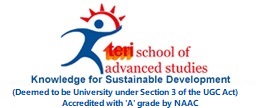
ANNOUNCEMENTS

| Date | News Title | Source |
| 18-July-2025 | 1 in 4 Indian married couples ... | The Indian Express |
| 23-June-2025 | Blended Learning: Driving educ... | The Pioneer |
| 22-June-2025 | All adults overweight in every... | |
| 21-June-2025 | TERI SAS Nurturing Global Sust... | The Interview World (Online) |
| 27-May-2025 | Eco-education trend grows: Sus... | India Today (Online- Education Desk) |
| 25-March-2025 | How water green credits can fu... | Hindustan Times (Opinion) |
| 23-February-2025 | Sustainable biz practices disc... | The Times of India (Online) |
| 21-February-2025 | Sangam fit for bath’, Enviro... | News9 (Online) |
| 12-February-2025 | A role for India in South-Sout... | The Hindu (Online) |
| 02-December-2024 | ICAR Findings Show 34% Decline... | ETV Bharat (Online) |
Gurgaon: Pictures of cars in bonnet-deep water on Golf Course Road had flooded the Internet during the monsoon last year. Rainwater had gushed into one of its seven underpasses and the city’s central boulevard — a totem of both its achievements and ambitions — was subsumed by its chornic drainage problem.
This year, Golf Course Road was the silver lining in the flooding that followed Monday’s rainfall in most other parts of the city. The road ans its underpasses were not affected by monsoon’s first heavy rainfall, an early indication that a move by GMDA and IAMGurgaon, an NGO, to build four drainage channels to divert water flowing from the Aravalis into natural creeks had been successful. Experts, however, said they would wait to see if the plan would stand up to heavy rain.
The four drainage channels have been built in sectors 26, 42, 54 and 56. The water from these drains flow into the natural creeks, which have been widened and made deeper to hold more water. Since these creeks are at a higher elevation, they absorbed much of the rainwater on Monday and stopped it from flowing into Golf Course Road. This also reduced pressure on the Badshahpur drain.
“The move has reduced stormwater runoff by almost 50%. In Gurgaon, flooding never occurred only because of the runoff from the Aravalis. We had to identify the bottlenecks in the natural creeks, make them wider and deeper so that they could hold more water. This took pressure off the Badshahpur drain, which gets flooded during the monsoon and inundates the nearby areas,”said Subhas Yadav, nodal officer (environment and sustainability wing) at GMDA.
Several native species, such as Pilkhan, Goolar, Neem, Baheda and Arjun, have also been planted around these creeks so that the soil doesn’t become loose and the embankments don’t give away.
The brain behind the move is a team of researchers from the Teri School of Advanced Studies. After last year’s flooding, GMDA had commissioned the Teri school a three-month study to find out the reasons and ways to stop water flowing from the higher reaches into Golf Course Road.
“We carried out a survey between September and December last year and shared our findings and recommendations with the GMDA. They acted upon them immediately and the result is there for you to see this monsoon. However, our study was restricted to Golf Course Road,” said Fawzia Tarannum, assistant professor at the department of regional water studies at the TERI school.
Latika Thukral of IAMGurgaon explained why the decision to make the creeks deeper would work this monsoon. “The Gurgaon-Faridabad highway and MG Road are 200 metres above Golf Course Road. So, rainwater would invariably gush into Golf Course Road. Now that the creeks have been made wider and deeper, they have a good capacity to carry the stormwater. The sand and silt at the bed of these creeks would also allow seepage,” she added.
Environmentalists, however, said they would adopt a wait and watch policy to see if the plan holds its ground during heavy rain. “GMDA should get experts to review the plan. They should plant long grass along the creeks so that the soil doesn’t become loose and water seeps into it. We are not sure if the plan will work in case of heavy rain. Let’s see,” said Vaishali Rana Chandra, an environmentalist. Residents, meanwhile, heaved a sigh of relief to see Golf Course Road unaffected by Monday’s rain. “This is a nice initiative by GMDA. Their plan has saved our area from getting flooded this time,” said Rahul Chandola, a resident of DLF 1.
Plot No. 10, Institutional Area, Vasant Kunj, New Delhi - 110 070, India.
Tel. +91 11 71800222 (25 lines).
Website : www.terisas.ac.in
Email id : registrar@terisas.ac.in
© Copyright © 2025, TERI SAS, All rights reserved.
Visitors No.: 46523986 Since 2023


